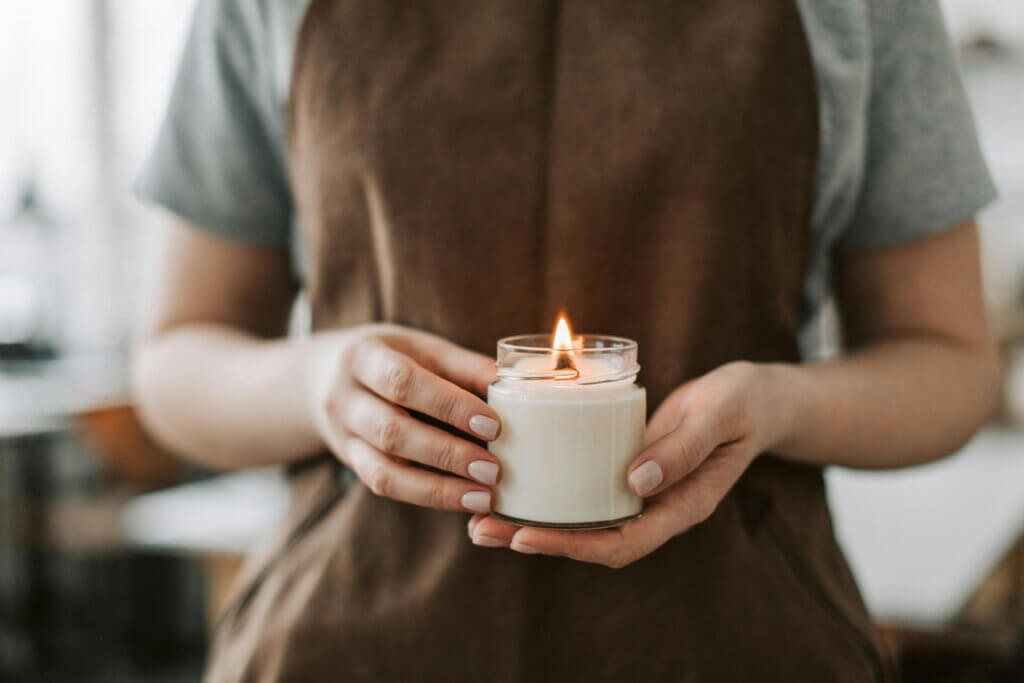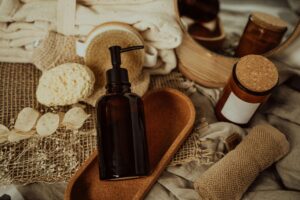Disclaimer: This post contains affiliate links, including links to Amazon. As an Amazon Associate, we earn from qualifying purchases at no additional cost to you. Thank you for supporting Low Tox & Thrive!
There’s something cozy and calming about lighting a candle at home. But not all candles are created equal. Many store-bought candles contain paraffin wax, synthetic fragrances, and heavy metals in their wicks, which can release harmful chemicals when burned.
If you want a cleaner, healthier way to enjoy candles, making your own non-toxic versions is a fantastic option—and pretty fun as well! Using natural ingredients like soy or beeswax, cotton wicks, and essential oils, you can create candles that are safer and better for indoor air quality.
In this guide, we’ll cover the ingredients needed for non-toxic candles, step-by-step directions to make the candles, and then finish off by diving further into why making your own candles is a switch worth making.
1. Choose the right wax
The foundation of a non-toxic candle is the wax, so start by choosing a natural, clean-burning option like beeswax, soy wax, or coconut wax:
Beeswax
Beeswax is one of the purest candle waxes available. It burns cleanly and even releases negative ions when burned, which can reduce indoor air pollutants.
Beeswax candles also naturally produce a soft honey scent, making them ideal for those who prefer a subtle fragrance. And if you’re burning it for ambiance rather than scent, you won’t even need to add essential oils to this one.
Soy wax
Soy wax is a plant-based, renewable option that burns cleanly and slowly, extending the candle’s lifespan. It holds essential oils well, which makes it a great choice for scented candles.
Look for 100% soy wax without additives to ensure it’s a truly non-toxic option.
Coconut wax
Coconut wax is a newer option in the candle-making world. It’s derived from coconut oil, making it eco-friendly and sustainable. But it’s often combined with other waxes, like soy, for better performance.
A good starting ratio for blending coconut wax with soy wax is 50:50. This blend offers the clean burn and fragrance-holding power of coconut wax while enhancing the stability and slower burn time of soy wax. Remember, though, that different brands can vary, so feel free to adjust and test small batches to find the perfect balance for your candles.
2. Choose your candle container
Reusable and heat-safe containers, like glass jars, ceramic bowls, or metal tins, are great for DIY candles. Look for containers with thick walls and ensure they’re heat-resistant to avoid cracking. Mason jars, vintage teacups, and recycled glass containers are popular choices that add personality to your homemade candles.
Avoid thin glass or ceramics that may crack, as well as plastics and non-heat-safe metals.
A slim container can help prevent “tunneling,” where the wax burns down only around the wick, leaving excess wax along the sides.
Make sure to clean and dry your container before pouring in the wax to ensure a smooth and even burn.
3. Choose a lead-free wick
Many store-bought candles contain wicks with metal cores that can release harmful chemicals like lead into the air. Opt for wicks made from natural cotton, hemp, or even wood to avoid these risks. Cotton wicks in particular are durable, burn cleanly, and come in various sizes to suit different types of candles.
To find the right wick size for your candle, check with your wax supplier, as wick size depends on factors like the type of wax, the container size, and the fragrance load.
4. Choose your essential oils
Instead of synthetic fragrances, use essential oils for a natural scent. Essential oils not only smell wonderful but also come with aromatherapy benefits.
Keep in mind, however, that not all essential oils are well-suited for candle making, as some may lose potency or even produce harmful fumes when heated to high temperatures. To ensure a safe, lasting scent, look for oils that retain their aroma and stability under heat (we’ll share some examples below).
Mixing essential oils with a carrier oil, such as fractionated coconut oil, can enhance the “throw,” or how well the scent disperses throughout the room. Note that some essential oils, like tea tree and eucalyptus, can be toxic to pets, so take extra care if you have animals at home.
Essential oils that work for candle-making
Here’s a list of essential oils that perform well in candles, preserving their scent and aromatherapy benefits even with the heat:
- Lavender: Known for its calming and stress-relieving properties, lavender essential oil is perfect for creating a tranquil atmosphere. It’s an excellent choice for bedtime candles or for use in relaxation spaces. The scent of lavender is also said to help ease mild headaches and tension.
- Eucalyptus: Eucalyptus oil provides a clean, crisp scent with a hint of menthol, creating a spa-like atmosphere. It’s popular for opening up the senses, reducing feelings of congestion, and helping to create a fresh, clean environment. Eucalyptus is ideal for bathrooms or areas where you’d like a relaxing, cleansing vibe.
- Cedarwood: Cedarwood essential oil has a warm, woodsy aroma that adds an earthy, grounding quality to candles. This oil is excellent for promoting relaxation, relieving tension, and even repelling insects.
- Peppermint: Peppermint oil has a refreshing and invigorating scent, making it ideal for candles in workspaces or areas where you need to focus. Its minty aroma may help improve concentration and increase mental clarity. Peppermint candles are also popular around the holidays for a festive, cool scent.
- Orange: Another cheerful, fruity scent, sweet orange essential oil is a good choice for an uplifting and comforting ambiance. It’s great for boosting mood and reducing stress, making it suitable for living rooms and other gathering spaces. Its fresh fragrance is also known to help deodorize.
Step-by-step candle-making process
What you’ll need
- Natural wax (beeswax, soy, or coconut wax)
- Cotton or hemp wicks
- Essential oils for scent
- Heat-safe containers
- Hot glue or wick stickers to attach the wick to the container
- A pencil or skewer to hold wick in place
- Double boiler or microwave-safe bowl
- Stirring utensil
Instructions
Step 1: Melt the wax
Using a double boiler, melt the wax over low heat, stirring occasionally until completely liquefied. If using a microwave, melt the wax in short bursts, stirring between intervals.
Step 2: Prepare the wick
Attach your wick to the bottom of the container with a bit of hot glue or a wick sticker to hold it in place. To keep the wick centered, wrap it around a pencil or a skewer placed horizontally across the top of your container, keeping it taut.
Step 3: Add essential oils
Once the wax is melted, allow it to cool slightly (around 120-140°F, depending on the wax type). Refer to your wax package for specific temperature guidance, as overheating can damage the oils’ scent.
Rather than adding drops, it’s better to weight out the fragrance load for accuracy. Most waxes support 6–10% essential oil, meaning for every 100 grams of wax, you can add up to 6–10 grams of essential oil. Check the recommended fragrance load of your wax for best results.
Step 4: Pour the wax
Slowly pour the scented wax into your prepared container, holding the wick steady. Leave a bit of space at the top for a clean look and to prevent wax from overflowing if it liquefies while burning. Allow the candle to cool and solidify completely (about 24 hours) in a room-temperature area.
Step 5: Trim the wick
Once the candle is fully set, trim the wick to about ¼ inch to ensure a controlled, clean burn when you light it. Enjoy your homemade candle!
Tips for safe candle use and maintenance
Keep wicks trimmed
Trimming your wick to ¼ inch before each use prevents excessive smoke and ensures a cleaner burn. Long wicks can lead to larger flames, which create more soot.
Burn candles in a ventilated area
Make sure to burn candles in well-ventilated spaces to disperse any particles released during combustion. Avoid burning candles near drafts, as uneven burning can lead to tunneling and wasted wax.
Limit burn time
Avoid burning candles for more than 3-4 hours at a time to reduce soot buildup and extend their lifespan. Letting a candle burn for too long can also cause the container to overheat.
Use candle snuffers
Instead of blowing out candles, use a snuffer or dip the wick into the wax to extinguish the flame. This reduces smoke and soot, creating a cleaner candle experience.
Ready to make your own non-toxic candle?
By choosing natural waxes, lead-free wicks, and essential oils, you can enjoy the warmth and beauty of candles without the risks associated with conventional ones. Whether for self-care, ambiance, or gift-giving, non-toxic candles are a worthwhile alternative to store-bought versions.







